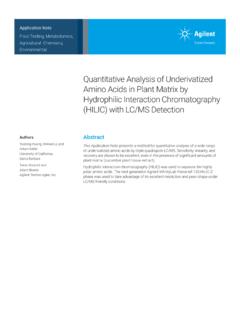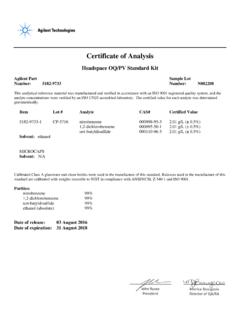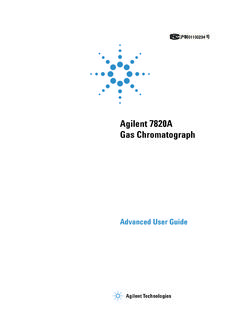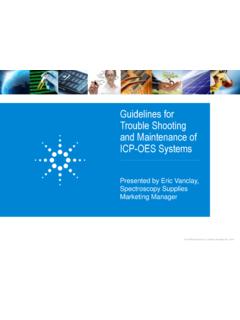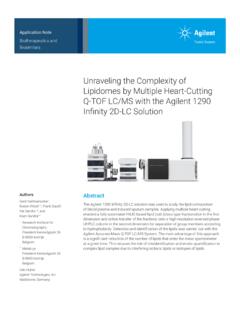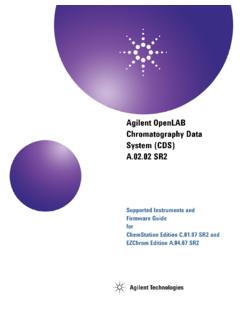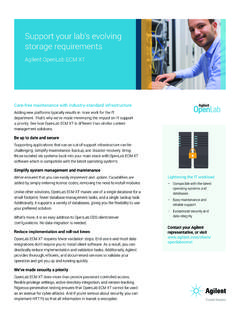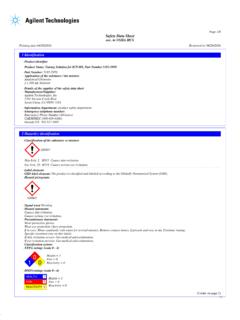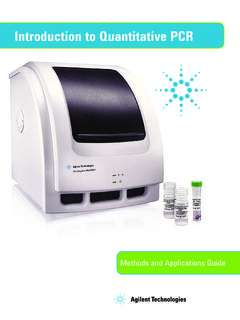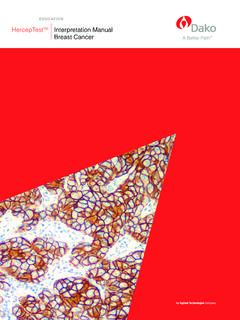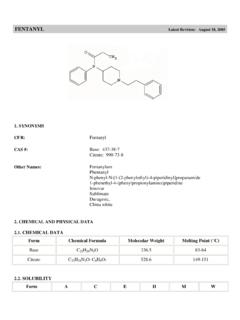Transcription of Profiling of Endogenous Metabolites Using Time-of-Flight ...
1 Profiling of Endogenous Metabolites Using Time-of-Flight LC/MS with Ion-Pair Reverse Phase ChromatographyApplication NoteAuthorYuqin Dai Agilent Technologies, Inc. 5301 Stevens Creek Blvd, Santa Clara, CA 95051 USAM etabolomicsAbstractA high performance ion-pair reverse-phase (IP-RP) chromatographic method has been developed for use with a Time-of-Flight (TOF) mass spectrometer (MS). This negative ionization method provides comprehensive coverage of many Endogenous metabolite classes including amino acids, organic acids, sugars and sugar phosphates, nucleosides and nucleotides, energy and redox Metabolites , and coenzyme A derivatives. Optimization of mobile phase pH and the LC gradient was critical in obtaining good chromatographic separation of isomers such as citric acid and isocitric acid, and impacted peak shape and optimal signal response.
2 The IP-RP LC/TOF MS method was evaluated with 19 representative metabolite standards covering the entire chromatographic region. All Metabolites showed good retention time 1100 isocratic pump (G1310A) with a 100:1 splitter (G1607-60000) for reference mass addition. Dynamic mass axis calibration was achieved by continuous infusion of a reference mass solution. Tables 1 and 2 summarize the optimized LC and MS acquisition and analysis was done Using the Agilent MassHunter software suite. The TOF MS provided sensitive, full spectrum data, which facilitated method development of the chromatographic conditions. amount of acetic acid was added to the organic mobile phase. All analyses were performed Using negative ion electrospray on an Agilent LC/TOF MS analysis was performed Using an Agilent 1290 Infinity LC coupled to an Agilent 6230 TOF with an Agilent Dual ESI Source.
3 The LC consisted of an Agilent binary pump with seal wash (G4220A), an Agilent sampler (G4226A) with thermostat (G1330B), an Agilent thermostatted column compartment (G1316C) and an IntroductionHigh resolution accurate mass LC/TOF or Q-TOF MS is routinely used in metabolomics for discovery work1-2. TOF MS is preferred due to spectral acquisition speed, high mass accuracy, high isotopic ratio fidelity, and sensitive detection of Metabolites . Some analytical challenges remain3-4, including retention of ionic Metabolites , reproducibility in retention time (RT), chromatographic separation of biologically important isomers, and broad coverage of metabolite classes in a single analytical run. To address these challenges, a robust and reproducible ion-pair reverse phase (IP-RP) LC/TOF MS method was developed Using tributylamine as the ion-pairing agent.
4 As part of the chromatographic optimization, the effect of both pH and concentration of tributylamine in aqueous and organic mobile phases was investigated. This method enables simultaneous detection of different classes of polar and anionic Endogenous Metabolites with separation of several pairs of biologically relevant isomers such as citric acid and isocitric acid. ExperimentalMethodA set of metabolite standards covering different chemical classes and several pairs of biologically relevant isomers was selected for IP-RP LC/TOF MS method development. Using a nonlinear water/methanol gradient, the chromatographic separation was performed on an Agilent ZORBAX RRHD Extend 80 C18, 150 mm, m column (p/n 759700-902) with an Agilent ZORBAX SB-C8, mm 30 mm, m (p/n 873700-936) guard column.
5 Tributylamine (Sigma, p/n 90781-50mL) was added to both aqueous and organic mobile phases to ensure a constant concentration during gradient elution. The pH of the aqueous mobile phase was adjusted Using acetic acid (Fluka, p/n 49199-50mL-F), and the same Table 1. The optimal LC 1290 Infinity LC SystemAnalytical columnAgilent ZORBAX RRHD Extend 80 C18, 150 mm, m (p/n 759700-902)Guard columnAgilent ZORBAX SB-C8, mm 30 mm, m (p/n 873700-936)Column temperature40 CInjection volume5 LAutosampler temperature4 CMobile phaseA) 97 % water/3 % methanol containing 5 mM TBA with pH adjusted by acetic acidB) Methanol containing 5 mM TBA with addition of acetic acidSeal wash solventIsopropanol : H2O (1:1 v/v)Flow mL/minGradientA nonlinear gradient from 0 99 % B in 22 minutesStop time22 minutesPost time5 minutesTable 2.
6 The optimal MS 6230 TOF systemIon modeNegativeSourceAgilent Dual ESIC apillary voltage3,500 VDry gas temperature250 C Dry gas flow13 L/minNebulizer pressure35 psiFragmentor130 VSkimmer60 VOct 1 RF Vpp600 VMS range 60 1,600 m/zMS acquisition spectra/secReference and pump mL/min Reference deliveryAgilent 1100 isocratic pump with 100:1 splitter (p/n G1607-60000)Instrument modeExtended dynamic range (2 GHz)3 Results and Discussion A robust, high-performance IP-RP LC/TOF MS method was developed Using an Agilent Extend column designed for robust performance at high pH. The addition of tributylamine improved retention of anionic Metabolites , allowing separation of both anionic and more hydrophobic Metabolites in a single method.
7 The separation of biologically relevant isomers was achieved by a combination of a stepwise nonlinear gradient and pH optimization of the mobile phase. This resulted in the separation of citric acid and isocitric acid, D-glucose-6-phosphate and -D-glucose-1-phosphate, leucine and isoleucine, and maleic acid and fumaric acid. Maintaining the same concentration of tributylamine in both aqueous and organic mobile phases helped control the pH. Furthermore, the concentration of tributylamine was decreased by half without causing any significant impact on the signal or separation. Generally, a lower concentration of buffer in the mobile phase will improve source cleanliness and system 1 illustrates that this method enabled detection of 38 Metabolites including amino acids, organic acids, sugars and sugar phosphates, nucleosides and nucleotides, energy and redox Metabolites , and coenzyme A derivatives with separation of biologically relevant isomers (Figure 2) in a 22-minute analytical run.
8 Table 3 summarizes the chemical formula, RT, and m/z values for these Metabolites . The chromatographically separated isomers are highlighted with four different 1. Overlaid extracted ion chromatograms (EICs) of 39 metabolite standards Using a mobile phase at pH = time (min)Counts12345678910111213141516171819 2021 Sugars and amino acidsNucleosidesSugar mono and di-phosphatesMono, di, and tri-organic acidsEnergy and redox Metabolites (for example, FAD, NAD(P)(H))Coenzyme A -D-G-1-PMaleic acidFumaric acidCitric acidIsocitric acid 105 Acquisition time (min)CountsFigure 2. Overlaid EICs showed chromatographic separations of four pairs of biologically relevant 3. A list of 38 Metabolites with chemical formula, RT, and (M-H) formula(M-H) RT (min) (Ave) (n = 3) acid acid (D-G-6-P) (D-F-6-P) acid -D-Glucose-1-phosphate ( -D-G-1-P) acid acid acid acid -Ketoglutarte acid acid acid ,6-bisphosphate (D-F-1,6-2P) CoA CoA CoA acid pairIsomer pairIsomer pairIsomer pair5phosphates and nucleotide triphosphates (Figure 3).
9 However, the signal intensities of a number of metabolite classes were impacted with this pH change (Figure 4). Effect of mobile phase pH on RT, selectivity, and signal intensityChanges to the pH of the mobile phase by adjusting the concentration of acetic acid can alter the RT and selectivity for sugar Figure 3. Effect of three mobile phase pH conditions on the RT and selectivity of some phosphorylated = = = = = 5pH = 5 ABCDEF 105 105 105 105 105 105 Acquisition time (min)Acquisition time (min)Acquisition time (min)Acquisition time (min)Acquisition time (min)Acquisition time (min)CountsCountsCountsCountsCountsCount sD-G-6-PD-G-6-PD-G-6-PD-F-1,6-2PD-F-1,6- 2PD-F-1,6-2P -D-G-1-P -D-G-1-P -D-G-1-PFigure 4. Effect of three mobile phase pH conditions on the signal responses of broad classes of Endogenous = 5pH = = -D-Glucose-1-PD-Fructose-1,6-2P = 5pH = = CoAIsobutyl CoA 1057pH = 5pH = = acidLactic acidPyruvic acidMaleic acidSuccinic acidFurmaric acid -KetoglutarateCitric acidIsocitric acidGlycochlic acid 1056 The magnitude of the signal intensity changes and the direction of RT shifts are highly dependent on the metabolite chemical class.
10 Results suggest that analytical selectivity and sensitivity for a specific class of Metabolites can be improved by controlling the pH of the mobile phase in IP-RP chromatography . In this study, a mobile phase at pH provided the best overall results for chromatographic separation of the isomers, with acceptable sensitivity among the different classes of Metabolites . Good RT reproducibilityReproducibility is important for reliable differential analysis and confident identification in metabolomics studies. To ensure that the developed IP-RP LC/TOF MS method is robust and reliable, 19 representative Metabolites covering the entire chromatographic region were selected for further evaluation. Table 4 shows that good reproducibility was achieved for RT.
